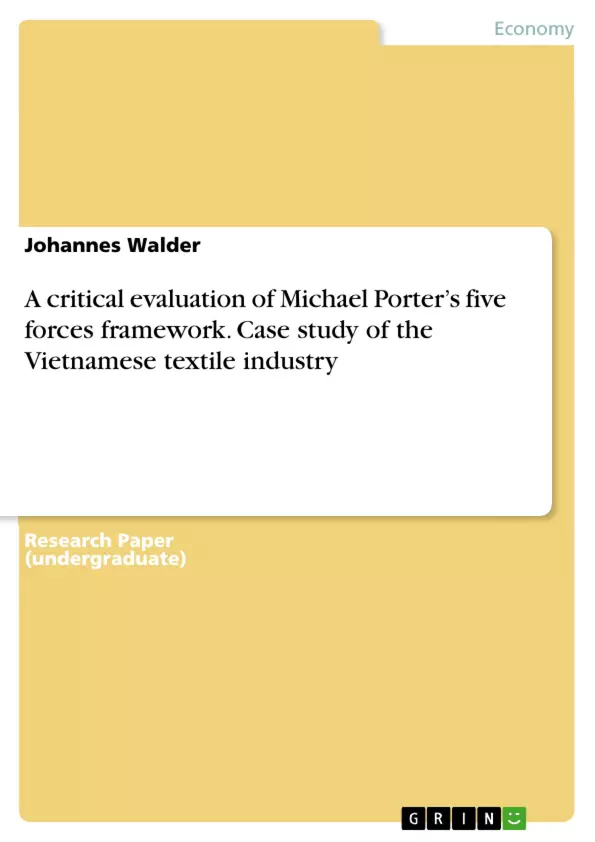In times of globalisation strategic decisions like diversification and international expansion become more and more important. As the economic world is developing into an increasingly intertwined network managers need strategic tools to facilitate their decisions. One of these models is the Five Forces model of Michael Porter. He developed this approach in 1980 in his book Competitive Strategy – Techniques for analysing industries and competitors. He claims that any industry has five basic forces that shape the internal competition.
This essay will analyse the underlying theories of the model and the its structure itself and apply it to a case study. The case study portraits the Vietnamese textile industry and their association with the government. By analysing the case study this paper will show the models insufficiencies and how it can be improved.
Inhaltsverzeichnis (Table of Contents)
- Introduction
- An analysis of Michael Porters Five Forces model and their underlying theories
- Evaluation of a market entry decision in the textile industry in Vietnam according to Porter
- Brief description of Vietnam
- Assessment of Vietnam according to Porters five forces model
- Power of the industry suppliers
- Local versus international buyers
- Substitutes for the textile industry
- Threat of new market entries
- Internal rivalry
- Concluding investment proposal
- Critical evaluation and further development of the five forces model
- Factors versus forces
- Interdependencies of the five forces
- Conclusion
Zielsetzung und Themenschwerpunkte (Objectives and Key Themes)
This essay aims to critically evaluate Michael Porter's five forces framework by analyzing its underlying theories, applying it to a case study of the Vietnamese textile industry, and examining its limitations. The objective is to highlight the model's strengths and weaknesses, suggesting potential improvements for future applications.- Analysis of Michael Porter's Five Forces Model and its underlying theories
- Application of the Five Forces model to a real-world case study: the Vietnamese textile industry
- Evaluation of the model's strengths and weaknesses
- Identification of areas for improvement and further development of the Five Forces model
- Exploration of the relationship between the Five Forces and strategic decision-making in a globalized context
Zusammenfassung der Kapitel (Chapter Summaries)
- **Introduction:** This chapter provides an overview of the importance of strategic decision-making in a globalized economy and introduces Michael Porter's Five Forces model as a valuable tool for analyzing industry competition. The chapter emphasizes the model's relevance to diversification and international expansion decisions.
- **An analysis of Michael Porters Five Forces model and their underlying theories:** This chapter delves into the structure and rationale of the Five Forces model, outlining its five key components: threat of new entrants, bargaining power of suppliers, bargaining power of buyers, threat of substitute products, and rivalry among existing competitors. It explores the model's focus on profitability as a key measure of success and contrasts it with other approaches like the market gap model.
- **Evaluation of a market entry decision in the textile industry in Vietnam according to Porter:** This chapter applies the Five Forces model to a specific case study—the Vietnamese textile industry. It provides a brief description of Vietnam's economic landscape and assesses the industry's competitiveness based on the five forces. The chapter examines the power of suppliers, buyers, substitutes, potential entrants, and the level of rivalry within the textile sector.
- **Critical evaluation and further development of the five forces model:** This chapter critically examines the Five Forces model, discussing its limitations and suggesting potential areas for improvement. It highlights the importance of considering interdependencies between the forces and explores the need to move beyond a purely theoretical framework to incorporate dynamic factors and industry-specific nuances.
Schlüsselwörter (Keywords)
This analysis delves into the theoretical foundations and practical applications of Michael Porter's Five Forces framework. Key themes include strategic decision-making, industry analysis, international expansion, competitiveness, profitability, market entry, and the Vietnamese textile industry.- Citation du texte
- Johannes Walder (Auteur), 2012, A critical evaluation of Michael Porter’s five forces framework. Case study of the Vietnamese textile industry, Munich, GRIN Verlag, https://www.grin.com/document/212377



